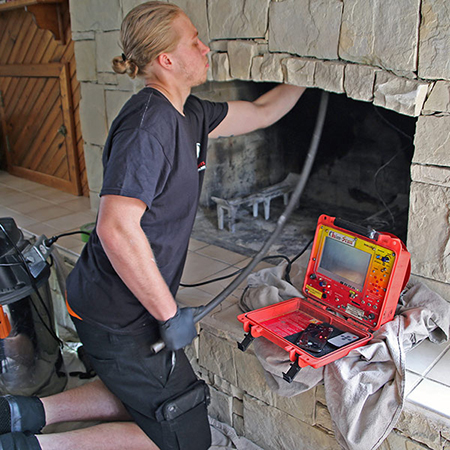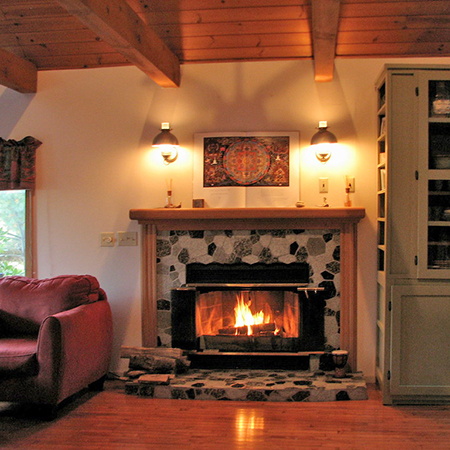Warm Up with Your Fireplace Safely This Fall
When the weather starts turning colder in the fall, it is tempting to light the fireplace. It takes the chill out of the air creating a warm and comfy indoor atmosphere. But before warming up the fireplace, its safe operation should be your top priority. House fires, burns, and carbon monoxide poisoning are potential problems that can arise. So, before you light the first fire of the season, follow these fireplace safety tips.
Chimney Inspection and Cleaning
 Is your fireplace safe to operate? There is no way to know for sure without a chimney inspection. Since creosote buildup is the leading cause of chimney fires, you need to be sure there isn’t an excessive accumulation in your chimney. A qualified chimney professional will measure the amount of creosote and recommend cleaning if necessary. But that’s not the only potential hazard. Obstructions, water leaks, and other issues can cause safety issues and reduce heating efficiency. A chimney professional will also visually examine the entire chimney for signs of physical damage, and check for any obstructions. Depending on the inspection results, your chimney professional may recommend cleaning and repairs.
Is your fireplace safe to operate? There is no way to know for sure without a chimney inspection. Since creosote buildup is the leading cause of chimney fires, you need to be sure there isn’t an excessive accumulation in your chimney. A qualified chimney professional will measure the amount of creosote and recommend cleaning if necessary. But that’s not the only potential hazard. Obstructions, water leaks, and other issues can cause safety issues and reduce heating efficiency. A chimney professional will also visually examine the entire chimney for signs of physical damage, and check for any obstructions. Depending on the inspection results, your chimney professional may recommend cleaning and repairs.
Fireplace Do’s and Don’ts
First, only fuel the fire with firewood that has been seasoned for at least six months. The moisture in unseasoned or “green” wood produces a smoky fire. Also, seasoned wood burns hotter, longer, which saves on fuel costs. Also, never throw painted materials, plastic, crates, furniture, Christmas trees, or treated wood into the fireplace. These materials produce toxic gases, which can be dangerous for you and your family. Second, the damper should be fully open when lighting the fireplace to allow smoke and fumes to vent.
Safely Lighting the Fireplace
 An easy and safe way to start the fire is to stack your logs in the fireplace. Add your kindling on the top layer of the logs. For kindling, use old newspapers, or dry twigs. You can also use some scraps of soft wood pieces like cedar, fir, or pine. Strike a good quality fireplace match to light the kindling. You should never use chemical fire accelerants to jump-start your logs. The fumes in flammable liquids such as gasoline, lighter fluid, and kerosene can ignite combustible materials surrounding your fireplace.
An easy and safe way to start the fire is to stack your logs in the fireplace. Add your kindling on the top layer of the logs. For kindling, use old newspapers, or dry twigs. You can also use some scraps of soft wood pieces like cedar, fir, or pine. Strike a good quality fireplace match to light the kindling. You should never use chemical fire accelerants to jump-start your logs. The fumes in flammable liquids such as gasoline, lighter fluid, and kerosene can ignite combustible materials surrounding your fireplace.
Never Leave a Fire Unattended
Never leave a burning fire in the fireplace unattended. Always extinguish the fire before leaving the house or retiring to bed. Close the damper when the fire is out.
Glass Fireplace Door
Installing a glass fireplace door will not only improve the aesthetics of your fireplace, but it also helps keep kids and pets away from the fire. It will also contain the heat in the firebox keeping your living space warmer. A wire mesh screen also comes in handy when you want to open the doors when kids or pets are not around.
Smoke and Carbon Monoxide Detector
It is recommended that homeowners install a smoke and carbon monoxide (CO2) detector on every level of their home with a solid or liquid fuel heating appliance. Carbon monoxide is an odorless, colorless, and tasteless gas that can result in deadly consequences. Test the batteries in your smoke and CO2 detectors at least twice annually.
The post Warm Up with Your Fireplace Safely This Fall appeared first on Fluesbrothers Chimney Service.